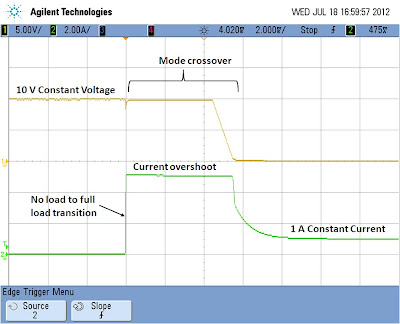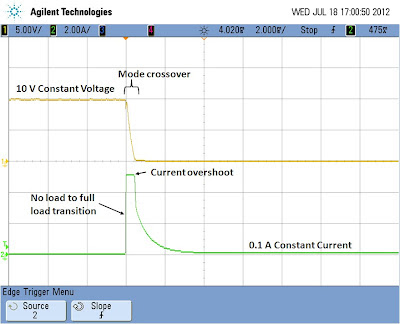One often encountered issue with power supply use is
expecting that the current limit will clamp the current to no greater than the
set value, only to discover the current initially overshoots when the DUT
demands current in excess of the set limit. In some cases the short surge of
excess current may be enough to damage a sensitive DUT. Those experienced with
power supplies will recognize this as a dynamic characteristic of mode
crossover.
What is mode crossover? Mode crossover is the transition point
between Constant Voltage (CV) and Constant Current (CC) modes. The dynamic
response characteristic of mode crossover is an aspect that separates real-world
from ideal-world power supplies. To start it will be helpful to review a
previous posting on “How Does a Power Supply regulate its Output Voltage and
Current?” Here it is shown there are two control loops in most power supplies,
one for regulating the voltage and one for regulating the current. Only one is
in control at any given time while the other is “open loop”. The error
amplifier that is open loop is up against it stops. When load conditions change
such that the power supply transitions through mode crossover the open loop
error amplifier needs to recover and gain control of the output. In the more
common case of the power supply operating as a voltage source there can be a
current overshoot during the brief moment when the load increases beyond the power
supply’s current limit setting. Conversely, for a current source, there can be
a voltage overshoot during the brief moment when the load decreases, causing
the output voltage to rise to the voltage limit setting.
The magnitude of the overshoot depends on many factors
relating to both the power supply and the DUT. Supplementary circuitry usually
surrounds the error amplifiers to clamp them from being driven into saturation
or cutoff so that they can more quickly recover when needed. Amplifiers are
carefully selected for their recovery characteristics. Careful design is
required to assure a stable transition between modes during crossover while at
the same time minimizing the delay and overshoot. The magnitude of the overshoot also depends
on how quickly and to what extent the DUT transitions between loading
conditions.
Figure 1 shows the mode crossover current overshoot of a
50 volt, 3 amp general purpose power supply, set for 10 volts and 1 amp
output. The loading DUT is an electronic
load set to transition from no load to 10 amps with a slew of 0.8 amps per
microsecond. This loading represented a worst case for all practical purposes.
When the load transitions to full (i.e. overload) it takes about 6 milliseconds
for the current limit control loop to fully take over and bring the current
down. During this mode crossover period the current overshoot plateaus at 5
amps, which is the gross current limit capacity of the power supply. Basically
this is the point where the power supply runs out of drive.
Figure 1: Constant voltage to constant current mode
crossover for 10 V, 1A power supply settings
In Figure 2 the power supply current limit was reduced to
0.1 amps and the mode crossover was again captured. This had an interesting
impact on the current overshoot. While the peak current still hit a plateau of
5 amps, the duration of the overshoot was considerably reduced to about 0.5
milliseconds. The reason for this is
there was a much larger difference driving the error amplifier’s input, causing
it to transition more quickly. The peak level remained unchanged as it is
determined by the power supply’s gross current limit capacity, which is fixed.
Figure 2: Constant voltage to constant current mode
crossover for 10 V, 0.1A power supply settings
The extent of an overshoot during mode crossover depends
on the power supply as well as the DUT. A power supply optimized for voltage
sourcing usually has very little voltage overshoot at mode crossover, but then
can have significant current overshoot, as we see here. Conversely, a power
supply optimized for current sourcing usually has very little current overshoot
at mode crossover, but then can have significant voltage overshoot. Higher
performance power supplies may provide faster and better mode crossover
performance, but this usually comes at greater expense. Some useful things to
do include:
·
Be aware that overshoot during mode crossover is
a reality that exists in most all power supplies
·
Try not to oversize the power supply. Be aware
that the peak level of voltage or current during mode crossover may be governed
more by the maximum voltage and current ratings of the power supply and less by
the settings. Using an oversized power supply with its limit set to 5% of its
capacity will likely yield a much larger overshoot than a smaller one with it
limit set to 50% of its capacity.
·
Understand the nature of your DUT, behavior or
fault modes that may cause it to draw an overload, and how sensitive it is to
an overload
·
If your DUT is sensitive to an overload, include
evaluating the response characteristics of mode crossover as part of your
evaluation, using realistic conditions that reflect the characteristics of your
DUT.


